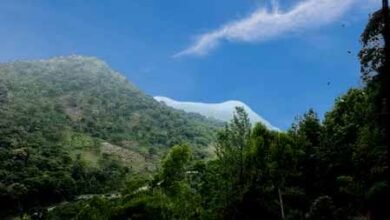
वनस्पति विज्ञान से संबंधित-121.
|
1. विकास का सिद्धान्त किसने प्रतिपादित किया था? = चार्ल्स डार्विन. 2. योग्यतम की उत्तरजीविता (survival of the fittest) का सिद्धांत प्रतिपादित किया है? = चार्ल्स डार्विन ने. 3. किसके द्वारा आनुवंशिकता के विज्ञान को ‘आनुवंशिकी’ कहा गया? = वॉटसन. 4. क्लोन किस विधि से उत्पन्न किया जाता है? = अलैंगिक विधि से. 5. एजोला को किस रूप में प्रयोग किया जाता है? = जैव उर्वरक के रूप में. 6. ‘जीवद्रव्य जीवन का भौतिक आधार है’ यह किसका कथन है? = लैमार्क. 7. शैवालों की कोशिका भित्ति किस पदार्थ की बनी होती है? = सेल्यूलोज. 8. फूलगोभी का खाने योग्य भाग कौन-सा होता है? = पुष्पक्रम. 9. ‘तना काट’ आमतौर पर किसके प्रवर्धन के लिए प्रयोग किया जाता है? = गन्ना. 10. नारियल का खाने योग्य भाग कौन-सा होता है? = भ्रुणपोष. 11. निषेचन क्रिया क्या है? = एक नर युग्मक का अण्डाणु से संयोजन. 12. जीवनचक्र की दृष्टि से पौधे का सबसे महत्त्वपूर्ण अंग कौन-सा है? = पुष्प. 13. कोशिका को एक निश्चित रूप कौन प्रदान करती है? = कोशिका भित्ति. 14. आरएनए (RNA) का मुख्य कार्य होता है? = प्रोटीन का संश्लेषण करना. 15. प्रकीर्णन किसे कहते हैं? = पौधों के बीजों के बिखरने को ही प्रकीर्णन कहते हैं. 16. मूलरोम किसे कहते हैं? = पेड़ों की जड़ों की सतह पर जो रोएँ से दिखाई देते है उन्हें मूलरोम कहते हैं . 17. पत्तियों का हरा रंग किसके कारण होता है? = पत्तियों का हरा रंग पर्णहरिम या क्लोरोफिल के कारण होता है. 18. काष्ठ किसे कहते हैं? = बहुवर्षी द्विबीजपत्री व नग्नबीजी के स्तम्भों में एधा वलय के विभाजन द्वारा इसके बाहर की ओर द्वितीयक फ्लोएम व भीतरी सतह पर द्वितीयक जाइलम का निर्माण होता है. द्वितीयक जाइलम को ही काष्ठ कहते हैं जो वृक्ष के स्तम्भ के भीतरी भाग का अधिकांश हिस्सा बनाता है. 19. पुष्प कितने प्रकार के होते हैं? = 04 (बाह्य दलपुंज (Calyx), दलपुंज (Corolla), पुमंग (Androecium) और जायांग (Gynoecium). 20. पुष्प किसे कहते हैं? = पुष्पीय पौधों में पुष्प एक अत्यन्त महत्त्वपूर्ण अंग होता है. आकारकीय रूप से पुष्प एक रूपान्तरित प्ररोह (स्तम्भ) है जिस पर गाँठे तथा रूपान्तरित पुष्पी पत्तियाँ लगी रहती हैं. पुष्प प्रायः तने या शाखाओं के शीर्ष अथवा पत्ती के अक्ष में उत्पन्न होकर प्रजनन (Reproduction) का कार्य करती है तथा फल एवं बीज उत्पन्न करता है. 21. बाह्य दलपुंज (Calyx) किसे कहते हैं? = यह पुष्प के सबसे बाहर का चक्र होता है. यह हरे छोटी पत्तीनुमा संरचनाओं का बना होता है जिन्हें बाह्य दल (sepals) कहते हैं. जब ये स्वतंत्र होते हैं तो इन्हें पृथक बाह्यदलीय (Polysepalous) कहते हैं और जब जुड़े होते हैं तो इन्हें संयुक्त बाह्यदलीय (Gamosepalous) कहते हैं. ये कली (Buds) को तथा उसके अन्य आन्तरिक भागों की सुरक्षा प्रदान करते हैं. कुछ पुष्पों में यह रंगीन होकर परागण के लिए कीटों को आकर्षित करने का काम करता है. 22. दलपुंज (Corolla) किसे कहते हैं? = यह पुष्प का दूसरा चक्र होता है जो बाह्य दलपुंज के अन्दर स्थित होता है. यह प्रायः 2-6 दलों (Petals) का बना होता है. आमतौर पर रंगीन होते हैं. इसका मुख्य कार्य परागण हेतु कीटों को आकर्षित करना है. जब दल (Petals) स्वतंत्र होते हैं, तो उन्हें पृथक दलीय (Polypetalous) तथा जब वे जुड़े होते हैं तो उन्हें संयुक्त दलीय (Gamopetalous) कहते हैं. 23. पुमंग (Androecium) किसे कहते हैं? = यह पुष्प का तीसरा चक्र है जो नर अंगों का बना होता है. प्रत्येक नर अंग पुंकेसर (stamen) कहलाता है. पुंकेसर ही पुष्प का वास्तविक नर भाग होता है. पुंकेसर के तीन भाग होते हैं- तन्तु या फिलामेंट (Filament), परागकोष या ऐन्थर (Anther) तथा योजी या कनेक्टिव (Connective). नोट:- पुतन्तु पतला सूत्रनुमा भाग होता है जो पुंकेसर को पुष्पासन से जोड़ता है. पुंकेसर में एक द्विपालिक (bilobed) रचना होती है जिसे परागकोष (Anthers) कहते हैं. परागकोष में चार कोष्ठ होते हैं, जिन्हें परागपुट (Pollen sacs) कहते हैं. परागपुट में ही परागकण (Pollen grains) की उत्पत्ति होती है. परागकण ही वास्तविक नर युग्मक (Male gamete) होता है. जब परागकोष पकने के बाद फट जाते हैं और परागकण प्रकीर्णन के लिए तैयार होते हैं. 24. जायांग (Gynoecium) किसे कहते हैं? = जायांग पुष्प का मादा भाग होता है. यह पुष्प का चौथा और सबसे भीतरी चक्र है. यह अण्डपों (Carpels) से निर्मित होता है. आकारकीय दृष्टि से अण्डप एक वर्टीकली मुड़ी हुई पर्ण है जिसके जुड़े हुए किनारों पर बीजाण्ड (Ovules) उत्पन्न होते हैं. इन्हीं बीजाण्डों में मादा युग्मक अण्डाणु होते हैं. विभिन्न पादपों में बीजाण्डों की संख्या निशिचत होती है. वर्तिका अंडाशय के ऊपर का लम्बा एवं पतला भाग होता है जबकि वर्तिकाग्र (stigma) वर्तिका (style) का सबसे ऊपर का भाग होता है जो प्राय: चिपचिपा होता है. =========== ============= ============ 1. Who propounded the theory of development? = Charles Darwin. 2. Who propounded the principle of survival of the fittest? = By Charles Darwin. 3. Who was the science of heredity called ‘Genetics’? =Watson. 4. Which method is the clone produced? = By asexual method. 5. How is Azolla used? = As organic fertilizer. 6. Whose statement is ‘Protoplasm is the physical basis of life’? = Lamarck. 7. What material is the cell wall of algae made of? = Cellulose. 8. Which is the edible part of cauliflower? = Inflorescence. 9. ‘Stem cutting’ is generally used for propagation of? = Sugarcane. 10. Which is the edible part of coconut? = Endosperm. 11. What is fertilization? = Union of a male gamete with an egg. 12. Which is the most important part of the plant from the point of view of life cycle? = flower. 13. What gives a definite shape to the cell? = cell wall. 14. What is the main function of RNA? = To synthesize proteins. 15. What is scattering? = The scattering of plant seeds is called dispersal. 16. What is root hair? = The hairs that are visible on the surface of the roots of trees are called root hairs. 17. What causes the green color of leaves? = The green color of leaves is due to chlorophyll or chlorophyll. 18. What is called wood? = In perennial dicotyledons and gymnosperms, by the division of the half ring, secondary phloem is formed on its outside and secondary xylem on the inner surface. Secondary xylem is called wood which makes up most of the inner part of the tree stem. 19. How many types of flowers are there? = 04 (Calyx, Corolla, Androecium and Gynoecium). 20. What is called a flower? = Flower is a very important organ in flowering plants. Morphologically, a flower is a modified shoot (stem) on which nodes and modified floral leaves are attached. Flowers usually arise at the top of the stem or branches or in the axils of the leaves and do the work of reproduction and produce fruits and seeds. 21. What is called calyx? = This is the outermost circle of the flower. It is made up of small green leaf-like structures called sepals. When they are independent, they are called separate sepals (Polysepalous) and when they are attached, they are called compound sepals (Gamosepalous). These provide protection to the bud and its other internal parts. In some flowers, it becomes colorful and works to attract insects for pollination. 22. What is called corolla? = This is the second whorl of the flower which is located inside the calyx. It is usually made up of 2-6 petals. Are usually colourful. Its main function is to attract insects for pollination. When the petals are independent, they are called separate-petalous (Polypetalous) and when they are attached, they are called compound-petalous (Gamopetalous). 23. What is Androecium? = This is the third whorl of the flower which is made up of male organs. Each male organ is called a stamen. The stamen is the actual male part of the flower. Stamens have three parts – filament, anther or anther and connective. Note:- Stamen is a thin thread like part which connects the stamen to the pistil. There is a bilobed structure in the stamen which is called anthers. There are four chambers in the anther, which are called pollen sacs. Pollen grains are produced in the anther itself. The pollen grain is the actual male gamete. When the anthers burst after ripening and the pollen grains are ready for dispersion. 24. What is Gynoecium? = Gymnosperm is the female part of the flower. This is the fourth and innermost chakra of the flower. It is made from carpels. Morphologically, the carpel is a vertically folded leaf on whose joined edges ovules are produced. These ovules contain female gamete ova. The number of ovules is fixed in different plants. The style is the long and thin part above the ovary while the stigma is the uppermost part of the style which is usually sticky.
|





